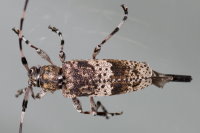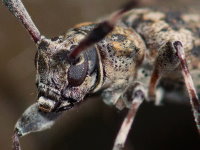Phylum Arthropoda (Arthropods) ➔ Subphylum Hexapoda (Hexapods) ➔ Class Insecta (Insects) ➔ Order Coleoptera (Beetles) ➔ Family Cerambycidae (Longhorn beetles)
Acanthocinus griseus (Fabricius, 1792)
Braunbindiger Zimmerbock
Synonyms and other combinations:
Acanthocinus griseus griseus Hasegawa, 1996 | Acanthocinus griseus novaki Breuning, 1963 ? | Acanthocinus griseus novaki Breuning, 1978 ? | Acanthocinus griseus novaki Lingafelter & al., 2014 | Acanthocinus griseus novaki Tippmann, 1952 | Acanthocinus griseus obscurus Breuning, 1978 | Acanthocinus griseus obscurus Pic, 1891 | Acanthocinus griseus obscurus Renaudié, 2003 | Acanthocinus (Acanthocinus) griseus Wallin, Kvamme & Lin, 2012 | Astynomus alpinus Redtenbacher, 1849 | Astynomus griseus Küster, 1847 | Cerambyx griseus Fabricius, 1793 | Cerambyx griseus Fabricius, 1801 | Cerambyx griseus Panzer, 1793 | Cerambyx griseus Zimsen, 1964 | Ædilis grisea Coulon, 1932 |
(?: ambiguous synonym)
Classification:
Acanthocinus griseus belongs to the subfamily Lamiinae, tribe Acanthocinini.Distribution:
In large parts of Europe (in Central Europe mainly in mountainous regions); from Siberia to Japan.Habitat:
Coniferous forest with deadwood.Description:
The variably patterned beetle with short grey and brown hair has a body length of 8 - 13 mm. The pronotum is finely punctured, 1.5 times as wide as long and carries a small and sharp spine on each side. The punctured, at the tip outside rounded elytra (forewings) are 3 times as long, as in the shoulder-area broad. In addition, 2 more or less distinct brown transverse stripes can be seen on the elytra.Males and females of the species are easily distinguishable. In females the antennae are one and a half times as long as the body, in males at least twice as long. In addition, the female has a clearly visible ovipositor.
Biology:
Adults of Acanthocinus griseus can be found from June to September. The beetles are active at dusk and at night and are attracted by light sources.After mating, the female lays the eggs with the ovipositor in narrow crevices in the bark of dead or freshly felled conifers. The larvae of Acanthocinus griseus are deadwood eaters (saproxylophages). They develop in the wood of pines (Pinus), spruce (Picea) and fir (Abies). After hatching, the larvae feed directly under the bark. If the bark is too dry or too thin, feeding galleries are also created in the sapwood. The pupation takes place in a pupal chamber, which is normally dug into the outer sapwood and whose entrance is closed with fine whitish wood fibres. The larvae hibernate.
Enemies:
Known parasitoids of the larvae of Acanthocinus griseus are the ichneumonid Xorides irrigator (Fabricius, 1793) [Hymenoptera: Ichneumonidae: Xoridinae] and the tachinid Billaea triangulifera (Zetterstedt, 1844) [Diptera: Tachinidae]. The larvae are often also preyed upon by woodpeckers during the winter.Note:
The Acanthocinus griseus shown here has flown into the apartment through the open balcony door at night. It was probably attracted by the light. After I put the beetle back out on the balcony the next day, it ran up the window and took a nap in a protected corner. The Acanthocinus griseus took off between 8:00 and 9:00 p.m..References, further reading, links:
- Tavakilian G. & Chevillotte H. (2019). TITAN: Cerambycidae database (version Apr 2015). In: Species 2000 & ITIS Catalogue of Life, 2019 Annual Checklist (Roskov Y., Ower G., Orrell T., Nicolson D., Bailly N., Kirk P.M., Bourgoin T., DeWalt R.E., Decock W., Nieukerken E. van, Zarucchi J., Penev L., eds.). Digital resource at www.catalogueoflife.org/annual-checklist/2019. Species 2000: Naturalis, Leiden, the Netherlands. ISSN 2405-884X.
- Martikainen, P. 2002: Ecology and conservation status of Acanthocinus griseus (Fabricius, 1792) (Coleoptera: Cerambycidae) in Finland. — Entomol. Fennica 13: 41–50.
- Acanthocinus griseus
- Agapanthia intermedia
- Brachyta interrogationis
- Callidium aeneum
- Cerambycidae sp.
- Gaurotes virginea
- Grammoptera abdominalis
- Leptura aethiops
- Oberea oculata
- Obrium cantharinum
- Oxymirus cursor
- Phytoecia nigricornis
- Stenostola sp.
- Tetrops sp.
- Xylotrechus arvicola
- Aspen Zebra Beetle
- Black Longicorn Beetle
- Black-striped Longhorn Beetle
- Blood-red Longhorn Beetle
- Common Grammoptera
- Fairy-ring Longhorn Beetle
- Four-banded Longhorn Beetle
- Golden-bloomed Grey Longhorn Beetle
- Hazel Longhorn Beetle
- Ladder-marked Longhorn Beetle
- Large Black Longhorn Beetle
- Lesser Capricorn Beetle
- Lesser Thorn-tipped Longhorn Beetle
- Lime Beetle
- Musk Beetle
- Paterson's Curse Stem Beetle
- Pine Sawyer Beetle
- Poplar Longhorned Beetle
- Red-brown Longhorn Beetle
- Ribbed Pine Borer
- Rufous-shouldered Longhorn Beetle
- Six-spotted Longhorn
- Small Poplar Borer
- Speckled Longhorn
- Spotted Longhorn
- Spruce Shortwing Beetle
- Tobacco-coloured Longhorn
- Variable Longhorn Beetle
- Violet Tanbark Beetle
- Wasp Beetle
- White-clouded Longhorn Beetle





